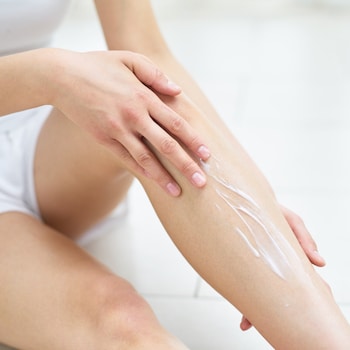
Can PFAS be absorbed through the skin?
This is the question many of you are asking lately.
You may have heard about PFAS in the news. Some cities and towns have found their water supplies contaminated with them.
According to a recent report from the Environmental Working Group (EWG), up to 110 million Americans could have PFAS in their water.
PFAS shows up in other places, too. The concern is that if you come into contact with these chemicals, your health may be at risk.
What Are PFAS?
Per- and poly-fluoroalkyl substances (PFAS) are a family of man-made chemicals. Companies have used them in a large number of consumer and industrial products since the 1950s. The first popular use was in non-stick cookware (Teflon). DuPont introduced its nonstick cookware coated with Teflon in 1946.
Since then, the chemicals have shown up in many more products and applications. They may appear in water-repellent clothing; stain-resistant fabrics, clothing, and furniture; some firefighting foams used on military and air bases; products that resist grease, water, and oil; and even in some cosmetics.
The problem is that during production and use, PFAS can migrate into the soil, water, and air. Most do not break down but remain in the environment.
According to the Centers for Disease Control and Prevention (CDC), because of their widespread use and their resistance to breakdown, “PFAS are found in the blood of people and animals all over the world and are present at low levels in a variety of food products and in the environment.”
Where PFAS May Be Lurking
The Environmental Protection Agency (EPA) states that PFAS can be present in many materials we find in our homes and workplaces, including:
- Drinking water
- Soil and water at or near waste sites (landfills, disposal sites, hazardous waste sites)
- Fire extinguishing foam (used to extinguish liquid-based fires at airports, shipyards, military bases, firefighting training facilities, chemical plants, and refineries)
- Manufacturing or chemical production facilities that make or use PFAS
- Food (fish caught from water contaminated with PFAS and dairy products from livestock exposed to PFAS)
- Food packaging (grease-resistant paper, fast food containers/wrappers, microwave popcorn bags, pizza boxes, candy wrappers)
- Household products and dust (stain and water-repellant used on carpets, upholstery, clothing, and other fabrics; cleaning products; nonstick cookware; paints, varnishes; sealants)
- Personal care products (shampoo, dental floss, cosmetics)
- Biosolids (fertilizer from wastewater treatment plants used on agricultural lands
 Can PFAS Be Absorbed Through the Skin?
Can PFAS Be Absorbed Through the Skin?
The CDC reports that yes, PFAS can get into your body through your skin. This is true of most chemicals that come into contact with your skin.
Fortunately, from what we know so far, only a small amount can get through.
The CDC states that showering and bathing in water containing PFAS “should not increase exposure.”
It’s worth noting, though, that if you sit in a hot tub for many minutes, you may be increasing your exposure.
The warm water opens up your pores, allowing more toxins in, and the longer length of time is a factor.
Can PFAS Be Absorbed Through the Skin in Cosmetics?
But that’s water. What about PFAS in cosmetics?
The U.S. Food and Drug Administration (FDA) notes that certain PFAS are “intentionally added” as ingredients in some cosmetic products. These include:
- Lotions
- Cleansers
- Nail polish
- Shaving cream
- Foundation
- Lipstick
- Eyeliner
- Eyeshadow
- Mascara
Manufacturers use PFAS in cosmetics to condition and smooth the skin, make it appear shiny, or affect product consistency and texture.
How can you tell whether your products contain PFAS? Look for these ingredients:
- Polytetrafluoroethylene (PTFE)
- Perfluorooctyl triethoxysilane
- Perfluorononyl dimethicone
- Perfluorodecalin
- Perfluorohexane
Some PFAS may also be present in cosmetics unintentionally as a result of raw material impurities or due to the breakdown of PFAS ingredients that form other types of PFAS.
As to whether these would be absorbed into your skin, it depends on a few factors:
- How healthy your skin is. (A damaged outer layer will allow more toxins in.)
- How long the product is in contact with your skin. (Lotions and foundations are riskier than cleansers that you rinse off.)
- How much skin you cover with the product. (Body lotions would be riskier than mascaras.)
- How much PFAS is in the product.
 Danger: Can PFAS Be Absorbed Through the Skin?
Danger: Can PFAS Be Absorbed Through the Skin?
You’re probably wondering by now: What are my health risks?
We need more research on these chemicals. But from what we know so far, exposure to certain levels of PFAS may lead to:
- Reproductive effects like decreased fertility or increased high blood pressure in pregnant women
- Developmental effects or delays in children, including low birth weight, accelerated puberty, or behavioral changes
- Increased risk of some cancers, including prostate, kidney, and testicular
- Reduced ability of the immune system to fight infections
- Interference with the body’s natural hormones
- Increased cholesterol levels and/or risk of obesity
Scientists are continuing to research PFAS to determine the exposure levels needed to increase the risk of health problems. This research is difficult, though, for a few reasons:
- There are thousands of PFAS and they may all affect the body differently.
- Exposure to PFAS occurs in different ways that may have different effects.
- The types and uses of PFAS change over time, so it’s challenging to track how exposure occurs and how it affects human health.
As an example of the last point, DuPont and other cookware manufacturers are no longer using the PFAS that have been linked to health problems in studies. They are, however, using other types of PFAS that may also be problematic.
What About the Danger of PFAS in Cosmetics?
The FDA notes that there have been few studies on the presence of PFAS in cosmetics. Those that have been published found that the concentration of certain PFAS ranged from the parts per billion level to the 100s of parts per million range. (Not a lot, in other words.)
Not all PFAS in cosmetics can be readily measured, as their detection is challenging.
We do have one study by Denmark’s Environmental Protection Agency that focused on five different types of PFAS found in cosmetics. The researchers determined that the levels in the individual products were unlikely to pose a health risk for consumers.
Data from this and other published studies are limited. We need more to determine the extent to which various PFAS in cosmetics may be absorbed through the skin and the potential for health risks from this type of exposure.
Can PFAS Be Absorbed Through the Skin? What to Do!
What can you do to reduce your risk of PFAS-linked health issues? First, check out the EWG’s free Guide to Avoiding PFAS Chemicals. Then try these tips:
- Check on your drinking water: If you have a personal well, test it for contaminants. Be sure to use a state-certified laboratory using EPA-developed testing methods. If you use a public drinking water system, ask your local water facility how they are addressing PFAS.
- Filter your water: Some in-home water treatment systems (filters) are certified to lower the levels of PFAS in your water. You can find more information on these here.
- Choose your fish: Avoid eating fish from waterways impacted by PFAS. Contact your state fish advisory program for more information.
- Limit foods packaged in containers with PFAS: Try to limit your consumption of fast food, microwave popcorn, and pizza packaged in containers that may have PFAS. Avoid take-out boxes too.
- Be cautious with nonstick cookware: Experts don’t all agree on the risks associated with nonstick cookware. Generally, it’s believed to be safe unless the coating is starting to flake off (due to age or high heat). If in doubt, choose other types of cookware.
- Skip the stain-resistant options: Stain-resistant carpet, furniture, and clothing may be convenient, but it may also expose you to PFAS. Many companies are phasing out their use of PFAS-coatings, but it’s best to always ask. The Green Science Policy Institute also has a list of PFAS-free products you can check.
- Choose your cosmetics carefully: Read the ingredient list on your cosmetics to be sure they don’t contain any of the ingredients listed above. Then buy your products from conscientious companies like CV Skinlabs. When formulating our products, we made sure not to use any PFAS ingredients.
Are you concerned about PFAS in your cosmetics?
Featured photo by Anna Shvets from Pexels.

